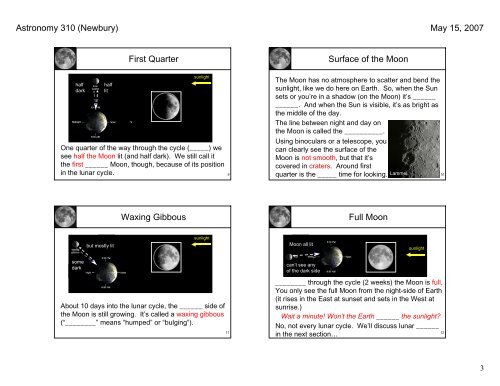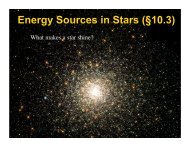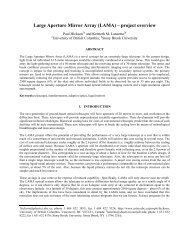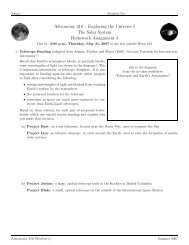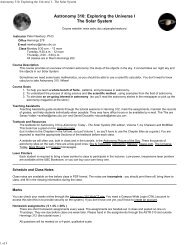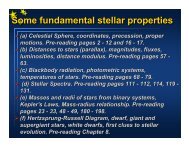The Motion of the Moon The Moon The Earth, Sun, and Time of Day
The Motion of the Moon The Moon The Earth, Sun, and Time of Day
The Motion of the Moon The Moon The Earth, Sun, and Time of Day
- No tags were found...
You also want an ePaper? Increase the reach of your titles
YUMPU automatically turns print PDFs into web optimized ePapers that Google loves.
Astronomy 310 (Newbury)<br />
May 15, 2007<br />
First Quarter<br />
Surface <strong>of</strong> <strong>the</strong> <strong>Moon</strong><br />
half<br />
dark<br />
half<br />
lit<br />
sunlight<br />
One quarter <strong>of</strong> <strong>the</strong> way through <strong>the</strong> cycle (_____) we<br />
see half <strong>the</strong> <strong>Moon</strong> lit (<strong>and</strong> half dark). We still call it<br />
<strong>the</strong> first ______ <strong>Moon</strong>, though, because <strong>of</strong> its position<br />
in <strong>the</strong> lunar cycle.<br />
9<br />
<strong>The</strong> <strong>Moon</strong> has no atmosphere to scatter <strong>and</strong> bend <strong>the</strong><br />
sunlight, like we do here on <strong>Earth</strong>. So, when <strong>the</strong> <strong>Sun</strong><br />
sets or you’re in a shadow (on <strong>the</strong> <strong>Moon</strong>) it’s ______<br />
______. And when <strong>the</strong> <strong>Sun</strong> is visible, it’s as bright as<br />
<strong>the</strong> middle <strong>of</strong> <strong>the</strong> day.<br />
<strong>The</strong> line between night <strong>and</strong> day on<br />
<strong>the</strong> <strong>Moon</strong> is called <strong>the</strong> __________.<br />
Using binoculars or a telescope, you<br />
can clearly see <strong>the</strong> surface <strong>of</strong> <strong>the</strong><br />
<strong>Moon</strong> is not smooth, but that it’s<br />
covered in craters. Around first<br />
quarter is <strong>the</strong> _____ time for looking. Lammel<br />
10<br />
Waxing Gibbous<br />
Full <strong>Moon</strong><br />
but mostly lit<br />
sunlight<br />
<strong>Moon</strong> all lit<br />
sunlight<br />
some<br />
dark<br />
About 10 days into <strong>the</strong> lunar cycle, <strong>the</strong> ______ side <strong>of</strong><br />
<strong>the</strong> <strong>Moon</strong> is still growing. It’s called a waxing gibbous<br />
(“________” means “humped” or “bulging”).<br />
11<br />
can’t see any<br />
<strong>of</strong> <strong>the</strong> dark side<br />
________ through <strong>the</strong> cycle (2 weeks) <strong>the</strong> <strong>Moon</strong> is full.<br />
You only see <strong>the</strong> full <strong>Moon</strong> from <strong>the</strong> night-side <strong>of</strong> <strong>Earth</strong><br />
(it rises in <strong>the</strong> East at sunset <strong>and</strong> sets in <strong>the</strong> West at<br />
sunrise.)<br />
Wait a minute! Won’t <strong>the</strong> <strong>Earth</strong> ______ <strong>the</strong> sunlight<br />
No, not every lunar cycle. We’ll discuss lunar ______<br />
12<br />
in <strong>the</strong> next section…<br />
3


